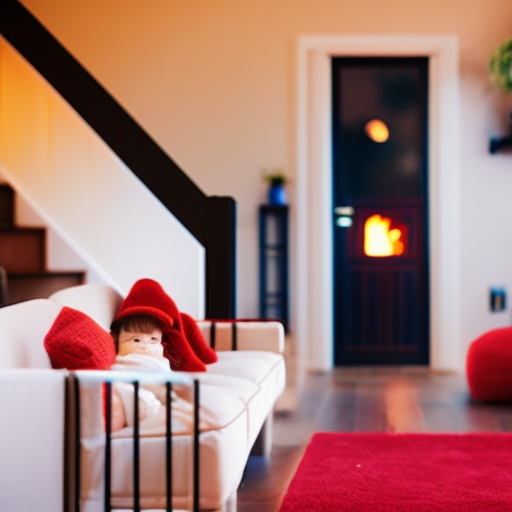Creating a Safe Home Environment
In the quest for a safe home environment, it’s often said that ‘safety starts at your doorstep.’ But what does that really mean?
Well, imagine your home as a fortress, its walls shielding you from the dangers that lurk outside. Now, picture yourself as the gatekeeper, responsible for ensuring that only safety and security find their way in.
Intrigued? Stay with me as we unlock the secrets to creating a safe haven for you and your loved ones.
Key Takeaways
- Implement safety measures such as installing smoke detectors and carbon monoxide detectors, securing the home against burglaries, and keeping valuables out of sight.
- Take fire safety measures by placing fire extinguishers, installing smoke alarms, testing them regularly, and cleaning and replacing them every ten years.
- Childproof the home by securing electrical outlets, installing safety gates, anchoring furniture, and using safety locks on cabinets and appliances.
- Prevent accidental falls by installing safety gates, anchoring heavy furniture, using window guards and stops, and ensuring safety gates are securely fastened.
Importance of a Safe Home
Creating a safe home environment is crucial for ensuring the well-being and security of yourself and your loved ones. Home accident prevention should be a top priority for every homeowner. By implementing proper safety measures, you can significantly reduce the risk of accidents and injuries within your home.
One of the most important safety measures to consider is installing smoke detectors and carbon monoxide detectors throughout your home. These devices can alert you to potential fires or gas leaks, allowing you to take immediate action and protect your family. Regularly checking and replacing the batteries in these devices is also essential to ensure their effectiveness.
Another important aspect of home accident prevention is securing your home against burglaries and break-ins. Installing sturdy locks on all doors and windows, as well as a security system, can deter potential intruders and provide peace of mind. Additionally, it’s advisable to keep valuables out of sight from the windows and to never leave spare keys hidden outside.
Furthermore, ensuring that your home is well-maintained is crucial for preventing accidents. Regularly inspecting and repairing any potential hazards, such as loose handrails or slippery surfaces, can prevent falls and injuries. Adequate lighting in all areas of the home is also essential for preventing accidents, especially in staircases and hallways.
Fire Safety Measures
To effectively protect your home and loved ones, it’s essential to implement fire safety measures that can prevent and mitigate the devastating effects of fires. Two important aspects of fire safety are fire extinguisher placement and smoke alarm maintenance.
When it comes to fire extinguishers, strategic placement is crucial. It’s recommended to have at least one fire extinguisher on each level of your home, with additional units in areas that pose a higher fire risk, such as the kitchen and garage. Make sure the fire extinguishers are easily accessible and properly maintained. Regularly check the pressure gauge to ensure they’re fully charged and ready for use. Also, familiarize yourself with the instructions on how to operate a fire extinguisher effectively.
Equally important is the proper maintenance of smoke alarms. Install smoke alarms on every level of your home, including inside each bedroom and outside sleeping areas. Test the alarms monthly and replace the batteries at least once a year. It’s crucial to keep the alarms clean and free from dust or debris that might interfere with their functionality. Additionally, replace smoke alarms every ten years to ensure they’re functioning optimally.
Childproofing and Baby Safety
Ensure the safety of your child and create a secure environment by implementing effective childproofing measures in your home. As a parent, it’s crucial to take proactive steps to prevent accidents and create a safe space for your little one to explore.
To help you in this endeavor, here is a practical babyproofing checklist to follow.
-
Start by securing all electrical outlets with outlet covers or plug protectors. These small but essential items prevent your curious child from inserting objects into the sockets.
-
Install safety gates at the top and bottom of stairs to prevent falls.
-
Ensure that all furniture and appliances are securely anchored to the wall to avoid tipping accidents.
-
Cover sharp edges and corners with corner guards or cushioned protectors, reducing the risk of injuries from falls or collisions.
-
Place safety locks on cabinets, drawers, and appliances to keep hazardous substances and sharp objects out of your child’s reach.
When it comes to childproofing products, there are various options available. Consider purchasing cabinet locks, toilet locks, and stove knob covers. Outlet covers with built-in night lights are also a practical choice, providing both safety and convenience. Additionally, invest in baby gates that are easy to install and use.
Preventing Accidental Falls
Secure your home to prevent accidental falls and create a safe environment for your child. To ensure your child’s safety, consider implementing the following fall prevention strategies and home modifications:
-
Install safety gates: Place safety gates at the top and bottom of stairs to prevent your child from accessing dangerous areas. Choose gates that are sturdy, easy to use, and securely fastened to the wall.
-
Secure furniture: Anchor heavy furniture, such as bookshelves and dressers, to the wall to prevent tipping. Use furniture straps or brackets to secure them firmly in place, especially if your child likes to climb.
-
Use window guards and safety nets: Install window guards on all windows above the ground floor to prevent falls. Make sure the guards are childproof and allow for easy escape in case of an emergency. For windows that can be opened, use window stops or safety nets to limit how far they can be opened.
Home Security Systems
Consider implementing a home security system to enhance the safety and protection of your family and belongings. In today’s world, where crime rates are increasing, it is crucial to take proactive measures to safeguard your home. With advancements in smart home technology, home security systems have become more accessible, affordable, and effective than ever before.
One of the key components of a modern home security system is surveillance cameras. These cameras provide round-the-clock monitoring of your property, both indoors and outdoors. They act as a deterrent to potential criminals and also provide valuable evidence in case of any unfortunate incidents. Surveillance cameras can be integrated with your smartphone, allowing you to access live feeds and receive alerts whenever there is suspicious activity detected.
To give you a better understanding of the various options available, here is a table showcasing some popular home security systems:
| System Name | Features | Price Range |
|---|---|---|
| XYZ Secure | HD Cameras, Motion Detection, Remote Access | $200-$400 |
| ABC Protect | Night Vision, Two-Way Audio, Smartphone Alerts | $300-$500 |
| DEF Guard | Facial Recognition, Cloud Storage, Smart Integration | $400-$600 |
| GHI Watch | Pan-Tilt-Zoom, Voice Control, Emergency Panic Button | $500-$800 |
Investing in a home security system is a proactive step towards securing your loved ones and your valuables. It provides peace of mind knowing that your home is protected, even when you are away. With the wide range of options available, you can find a system that suits your needs and budget. So, take the necessary steps today to create a safe and secure home environment.
Creating a Healthy Indoor Environment
To maintain a healthy indoor environment, it’s important to be mindful of the air quality and cleanliness of your home. The indoor air quality can have a significant impact on your overall health and well-being. Here are three key factors to consider when it comes to creating a healthy indoor environment:
-
Ventilation: Proper ventilation is essential for maintaining good indoor air quality. Make sure your home is well-ventilated by opening windows regularly, using exhaust fans in bathrooms and kitchens, and ensuring that air ducts are clean and in good working condition.
-
Air purification: Invest in an air purifier to remove pollutants and allergens from the air. Look for a purifier with a HEPA filter, which can effectively capture small particles like dust, pollen, and pet dander.
-
Mold prevention: Mold can be a major health hazard, causing respiratory issues and allergic reactions. To prevent mold growth, keep humidity levels in check by using a dehumidifier, fixing any leaks or water damage promptly, and ensuring proper ventilation in areas prone to moisture, such as bathrooms and basements.
Ensuring Electrical Safety
To ensure the safety of your home’s electrical system, it’s essential to regularly inspect and maintain your electrical components. Conducting electrical inspections is a crucial step in identifying potential hazards and preventing accidents. It’s recommended to hire a certified electrician who can thoroughly examine your wiring, outlets, switches, and other electrical equipment. They’ll check for any signs of wear and tear, loose connections, or outdated components that may pose a risk. Regular inspections can help identify and rectify any issues before they escalate into dangerous situations.
In addition to inspections, electrical maintenance is equally important in keeping your home safe. This involves taking proactive measures to ensure the proper functioning of your electrical system. It includes tasks such as replacing faulty wiring, repairing or upgrading outdated outlets and switches, and cleaning dust and debris from your electrical panels. Regular maintenance can help prevent electrical fires, short circuits, and electrical shocks.
Safe Storage and Handling of Hazardous Materials
Safely storing and handling hazardous materials is crucial for maintaining a secure home environment. It’s essential to take proper precautions to prevent accidents and protect yourself and your loved ones. Here are three important tips to ensure the safe storage and handling of hazardous materials:
-
Proper labeling and storage: Always label containers with the name of the hazardous material, along with any necessary warnings. Store these materials in a designated area, away from children, pets, and food. Keep them in their original containers whenever possible, and ensure they’re tightly sealed to prevent leaks or spills.
-
Hazardous waste disposal: Dispose of hazardous materials properly to minimize environmental harm. Research local guidelines and regulations for the disposal of specific substances. Look for community programs or special collection days for hazardous waste disposal. Never pour hazardous materials down the drain or throw them in the regular trash.
-
Chemical safety precautions: When handling hazardous materials, always wear appropriate protective gear, such as gloves, goggles, and a mask. Work in a well-ventilated area to minimize exposure to harmful fumes. Avoid mixing different chemicals unless instructed to do so. Take extra care when handling corrosive, flammable, or toxic substances.
Emergency Preparedness and First Aid Kit Essentials
Are you prepared for emergencies? It’s crucial to have an emergency response plan in place and essential emergency supplies readily available in your home. In times of crisis, every second counts, and being equipped with the right tools and knowledge can make a significant difference in the outcome.
First and foremost, create an emergency response plan tailored to your household’s needs. Discuss evacuation routes, meeting points, and communication methods with your family members. Ensure everyone knows how to access emergency services and when to call for help.
When it comes to essential emergency supplies, a well-stocked first aid kit is a must-have. Include items like adhesive bandages, gauze pads, antiseptic wipes, and a thermometer. Consider any specific medical needs, such as prescription medications or allergy medications, and include them in your kit.
Other essential emergency supplies include a flashlight, batteries, a portable radio, and a whistle for signaling for help. Keep a supply of non-perishable food, water, and a manual can opener in case of extended power outages or natural disasters. Additionally, having a basic toolkit, extra blankets, and a fire extinguisher can provide peace of mind in emergency situations.
Regularly check and replenish your emergency supplies to ensure they remain up-to-date and functional. Remember, being prepared isn’t just about having the right supplies; it’s about having a plan and practicing it with your loved ones.
Stay safe!
Frequently Asked Questions
How Can I Teach My Children About the Importance of a Safe Home Environment?
You can teach your children about the importance of a safe home environment by explaining the potential dangers, setting clear rules, and leading by example. Show them how to be cautious and responsible in order to create a secure and nurturing space.
Are There Any Specific Fire Safety Measures for Homes With Elderly Individuals?
To ensure the safety of elderly individuals in your home, it’s crucial to implement specific fire safety measures. Recognizing the importance of home safety for seniors can help prevent accidents and provide peace of mind.
What Are Some Common Household Items That Pose a Choking Hazard to Babies?
Common household items such as small toys, coins, buttons, and food like grapes and nuts can pose a choking hazard to babies. It’s important to be vigilant and keep these items out of their reach.
How Can I Ensure That My Home Is Safe for Older Adults to Prevent Accidental Falls?
To prevent accidental falls and create a safe environment for older adults, start by decluttering pathways, securing rugs, installing grab bars in bathrooms, and adding adequate lighting. These steps can greatly reduce the risk of falls and ensure their safety.
What Are Some Tips for Choosing the Right Home Security System for My Specific Needs?
When choosing the right home security system for your specific needs, consider factors such as the size of your home, your budget, and the level of monitoring you desire. Research and compare options to make an informed decision.
Conclusion
Creating a safe home environment is like constructing a fortress for your loved ones, where they can thrive and feel secure. By implementing fire safety measures, childproofing, and preventing accidental falls, you can ensure their physical well-being.
Additionally, installing home security systems and practicing electrical safety will protect them from potential dangers.
By creating a healthy indoor environment and safely storing hazardous materials, you safeguard their long-term health.
Lastly, being prepared for emergencies and having a well-stocked first aid kit is like having a lifeline in times of need.







